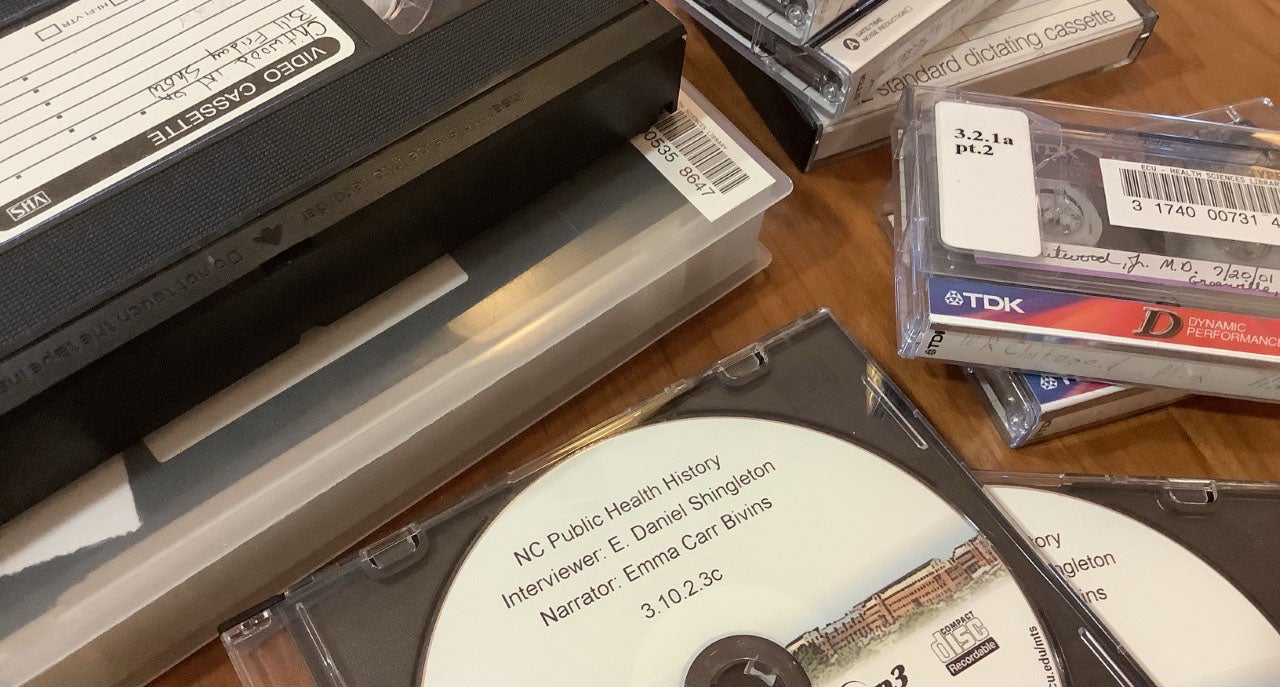Oral History Digitization Project
Digitization has become an important aspect of historical archiving and the preservation of rare materials in libraries. Laupus Library’s History Collections has digitized many items from our collection over the past few years to convert files from analog to digital format. We also digitize items to aid in long term preservation. Most recently, we embarked on an Oral History Digitization Project to ensure the oral histories in our collection were preserved and accessible. As of August 15, 2019, 42 oral histories are now hosted in the ECU Digital Collections.
This project involved several steps, which I will highlight in this post. I’ll walk through this nearly year-and-a-half long project, highlighting the planning process, item preparation, digitization and hosting, and discoverability and accessibility.
Planning
In our library’s archives, we have a collection devoted to oral histories. However, we also have several other audio files with interviews and filmed forums scattered throughout other historical collections in our repository. We started the project by initially digitizing items in the Oral History Collection, but we have since expanded the scope.
The first step of the planning process was to create an inventory of the entire Oral History Collection. This included listing the type of media each interview is on (audio cassette, VHS, compact disc, etc.), if we have a transcript for the interview, and if we have biographical information about the interviewee. Additionally, the spreadsheet inventory included space to check off each step in the process as it was completed. This spreadsheet became the master document for tracking our progress throughout the project.

Section of the Oral History Inventory and Project Tracking Spreadsheet
Once the inventory was complete, I began focusing on the interviews that had signed releases. At the beginning of the project, we decided we would only host interviews online for which we had a media release form. We are still trying to track down interviewees and relatives of the interviewees to acquire signed releases and make our oral histories even more accessible.
The final step in the planning process was to communicate with Joyner Library’s Application and Digital Services Department and Digital Collections. I met with department head, Amanda McLellan, to discuss the project and determine the best time to begin sending items to Digital Collections based on their other projects and work load. By communicating with Digital Collections from the beginning, I was able to work with their schedule and explain the project, while also ensuring that they understood our goals.
Item Preparation
The next major step was to prepare items for digitization and online hosting. I first needed to decide how many oral histories to send at one time and which interviews to send first. I ultimately elected to send the interviews in alphabetical order.
Since the library completing this phase of the project is on another campus in town, I had to coordinate when to drop off the items. For convenience, I only selected the number of interviews that fit in one box—usually around seven or eight—and hand delivered the box to Digital Collections. Prior to delivery, however, I used the online digitization request system to submit information about each interview. This helps Digital Collections track the request and attach titles, dates, and descriptions to each interview once it is digitized.

Oral History Interview with Dr. Kathryn Kolasa
Digitization and Online Hosting
After I submitted the request and delivered the box, Digital Collections took over from there. Digital Services Production Coordinator, Joe Barricella, and Media Production Specialist, Justin Borer, made the process so easy and always communicated with me when they had questions. Once Justin completed digitization of the files and hosted them online, he emailed me the links so that I could begin adding descriptive metadata.
Discoverability and Accessibility
The project wasn’t complete once the items were hosted online. Most digital objects are difficult to find without descriptive metadata like object descriptions, subject headings, and dates. Thus, the final step in this project was to create and upload descriptive metadata for each interview.
Student workers and interns played an important role in developing the descriptive metadata. I tasked the students with listening to each interview and completing a descriptive metadata template. Once they completed their work, I would then format the information and update the object descriptors for each interview. In some cases, I created a temporary summary for interviews while the students worked through them.
The final aspect of discoverability and accessibility for oral history interviews are the transcripts. Fortunately, most of our interviews have transcripts already. I submitted our transcript files to Digital Collections, and they are adding them to each respective interview as time permits. Soon, transcripts for most of our oral histories will be online!
Our oral histories can be accessed online in our Oral History Collection on the Digital Collections website. Stay tuned for more oral histories to become accessible online as new interviews are conducted and as we receive more signed releases for others in our physical collection.
